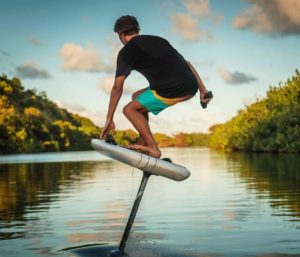Water Foiling Board: What Sets It Apart?
The realm of water sports is witnessing an unprecedented revolution with the advent of the water foiling board, a marvel of engineering that promises to redefine the boundaries of surfing, kiteboarding, and stand-up paddleboarding. But what exactly catapults this innovative equipment into a league of its own? Let's delve into the mechanics, performance, and unique features that distinguish the water foiling board from traditional watercraft, offering a deep dive into the numbers and specifics that illustrate why it stands as a beacon of modern aquatic sports.

The Science of Lift: Engineering Marvel
At the core of a water foiling board's allure is its hydrofoil, a wing-like structure mounted beneath the board. This design enables the board to rise above the water's surface, significantly reducing drag and allowing for smoother, faster rides. The hydrofoil typically comprises carbon fiber or aluminum, materials chosen for their strength-to-weight ratio and durability in aquatic environments. The magic begins as soon as the board reaches speeds between 4 to 8 mph, at which point the hydrofoil generates enough lift to elevate the board above the water.
Elevated Performance: Speed and Agility
The key performance indicator of a water foiling board is its ability to sustain lift at low speeds, making it vastly more efficient than traditional surfboards or paddleboards. This efficiency translates into higher speeds and unparalleled agility on the water. Riders can achieve velocities upwards of 25 mph, a feat nearly impossible on a standard surfboard without mechanical assistance. Moreover, the agility offered by the hydrofoil allows for tighter turns and more dynamic maneuvers, enabling riders to dance across the water's surface with grace and precision.
Unmatched Versatility: Riding Beyond Waves
One of the most compelling features of a water foiling board is its versatility. Unlike traditional surfboards that rely on waves for propulsion, water foiling boards can glide over flat water, choppy conditions, and even against currents. This versatility opens up new water landscapes for exploration and enjoyment, from serene lakes to bustling ocean fronts. Whether it's downwind racing or leisurely cruising, the water foiling board offers a unique blend of experiences that cater to a wide range of interests and skill levels.
Sustainability and Accessibility: A New Era of Water Sports
The rise of the water foiling board signifies a shift towards more sustainable and accessible water sports. Without the need for fuel or waves, it presents an eco-friendly alternative to motorized watercraft while democratizing access to thrilling water-based activities. Its appeal extends from seasoned surfers seeking new challenges to beginners intrigued by the prospect of flying over water. The board's design also minimizes disturbances to marine life, aligning with a growing awareness and respect for oceanic environments.
Investment in Innovation
Adopting a water foiling board does come with a significant price tag, reflecting the advanced technology and materials involved in its construction. Prices range from $1,000 for entry-level models to over $2,000 for premium variants. However, enthusiasts argue that the cost is justified by the board's transformative potential and the unparalleled experiences it offers.
Final Thoughts
The water foiling board is not just another piece of sports equipment; it's a testament to human ingenuity and a symbol of the evolving relationship between technology and nature. By offering a harmonious blend of speed, agility, and versatility, it sets a new standard in water sports, inviting both novices and veterans to redefine what's possible on the water. As this exciting technology continues to evolve, it promises to bring even more enthusiasts into the fold, forever changing the landscape of aquatic adventure.
